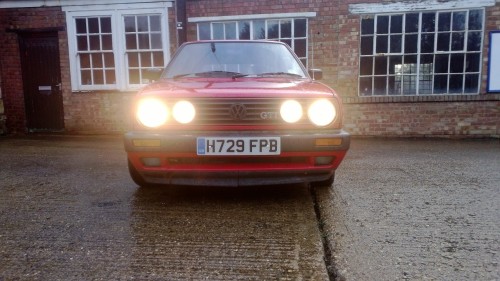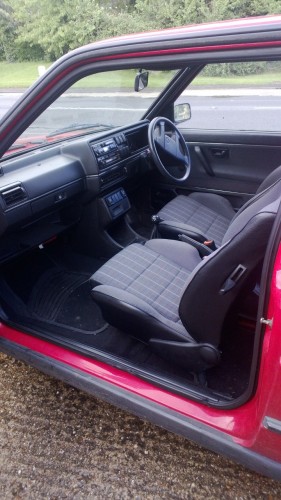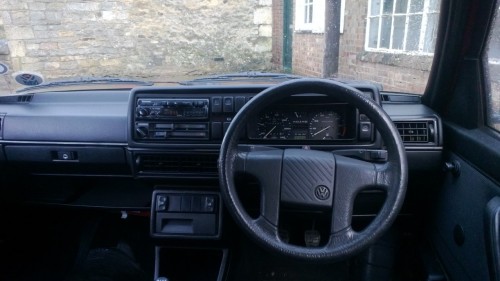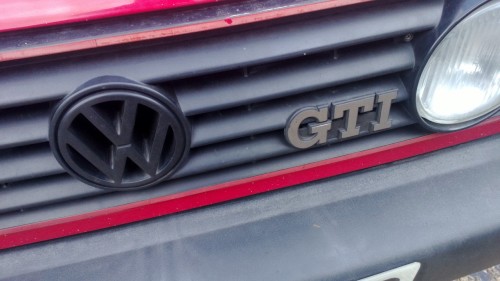 Well, well, what’s this? A road test of a Golf? And a sporty Golf, what’s more! I apologise to anyone who was holding out for a test of a brown Chrysler Sunbeam 928, but I assure you that normal service will be resumed as soon as possible.
Well, well, what’s this? A road test of a Golf? And a sporty Golf, what’s more! I apologise to anyone who was holding out for a test of a brown Chrysler Sunbeam 928, but I assure you that normal service will be resumed as soon as possible.
It’s quite hard trying to come up with an introductory paragraph for the Golf GTI. It’s a motoring icon that defined both a decade and an entire genre of cars and if you were to add up all the column inches that have gushed about the GTI over the years as a whole it would probably stretch for an interstellar distance.
The stock opening ‘The Golf GTI needs no introduction’ is usually followed by 500 words doing just that, so I’m not going to write that. Really, I suppose the objectives for this road test are:
1) The obvious- What is a Mk2 Golf GTI like to drive?
2) The critical- is it worth the hype?
3) The personal- do I like it?
Without further ado, let’s start with the appearance:
Outside
 The Mk2 Golf is really just a moving piece of street furniture. The shape has evolved by frustrating increments since the ‘Seventies and was never a particularly ground-breaking piece of styling even then. The survival rate of Mk2s is high enough that you see them around to the extent that you don’t even notice them, let alone realise that it’s a 30-year old car.
The Mk2 Golf is really just a moving piece of street furniture. The shape has evolved by frustrating increments since the ‘Seventies and was never a particularly ground-breaking piece of styling even then. The survival rate of Mk2s is high enough that you see them around to the extent that you don’t even notice them, let alone realise that it’s a 30-year old car.
The Volkswagen connoisseurs generally proclaim the Mk2 to be the high-water mark of styling (these things are all relative, I suppose) and I can see the point. Even on the second iteration the Golf had started to put on some flab. It doesn’t have the steam-creased edges and tight lines of the Giugiaro original- there is a slight bulginess to the sides and the car somehow manages to look bigger than it actually is. None the less it’s a thoroughly effective and inoffensive piece of design that really does blend in anywhere. I took the Golf to several different places in search of photos, from an inner-city underpass strewn with graffiti to a shady side-lane in a prosperous rural commuter village and it looked ‘right’ at both locations and everywhere in between.
 The Golf GTI’s premium image rested on it being a more ‘mature’ car than the wide-boy looks of the fast Fords with their preposterous spoilers and excessive wheel arches or the likes of Peugeot with their vivid paint and go-faster stripes. At a glance you would struggle to differentiate the GTI from one of its more hum-drum siblings. This is especially the case with this example because the red paintjob masks the sporty red detailing around the grille and the GTI badges on the rubbing strakes. This H-reg car doesn’t even have the BBS cross-hatch alloys which seemed to be virtually standard-fitment to GTIs by the late ‘Eighties. Instead it has rather plain plastic wheel trims.
The Golf GTI’s premium image rested on it being a more ‘mature’ car than the wide-boy looks of the fast Fords with their preposterous spoilers and excessive wheel arches or the likes of Peugeot with their vivid paint and go-faster stripes. At a glance you would struggle to differentiate the GTI from one of its more hum-drum siblings. This is especially the case with this example because the red paintjob masks the sporty red detailing around the grille and the GTI badges on the rubbing strakes. This H-reg car doesn’t even have the BBS cross-hatch alloys which seemed to be virtually standard-fitment to GTIs by the late ‘Eighties. Instead it has rather plain plastic wheel trims.
 The most obvious visual difference is at the front, where the grille has a set of secondary driving lamps mounted inboard of the main units. This wasn’t a GTI-only feature but the formula of “more lights=sporty” is a well-proved one and it works. It gives the frontal aspect a crucial bit of presence and removes the standard car’s rather plain, almost cute, looks that most basic round-lamp cars have. Although the grille also has a GTI badge it is still moulded from subtle grey plastic (or silver-effect faded to silver…). Round the back, there is another modest badge and a twin-exit exhaust protruding from the bumper which hints at the car’s potential.
The most obvious visual difference is at the front, where the grille has a set of secondary driving lamps mounted inboard of the main units. This wasn’t a GTI-only feature but the formula of “more lights=sporty” is a well-proved one and it works. It gives the frontal aspect a crucial bit of presence and removes the standard car’s rather plain, almost cute, looks that most basic round-lamp cars have. Although the grille also has a GTI badge it is still moulded from subtle grey plastic (or silver-effect faded to silver…). Round the back, there is another modest badge and a twin-exit exhaust protruding from the bumper which hints at the car’s potential.
 The GTI version of the Golf sits on lower, stiffer suspension than the normal cars and it has the wider black plastic wheel arches fitted to some of the other trim levels at the time. Again, these changes are subtle in the extreme. The car doesn’t look like it’s dragging its silencer on the ground and the tyres are on a higher profile that most SUVs available today. The differences only become noticeable when you compare it to a standard Golf. This later car has the deeper bumpers with chunkier anti-deforming sections which help to beef up the appearance but it still doesn’t look like one of the most highly regarded sporting car models of all time. It looks like a normal three-door hatchback from the ‘Eighties. If there’s any excitement to be had from a GTI, it’s not from the appearance.
The GTI version of the Golf sits on lower, stiffer suspension than the normal cars and it has the wider black plastic wheel arches fitted to some of the other trim levels at the time. Again, these changes are subtle in the extreme. The car doesn’t look like it’s dragging its silencer on the ground and the tyres are on a higher profile that most SUVs available today. The differences only become noticeable when you compare it to a standard Golf. This later car has the deeper bumpers with chunkier anti-deforming sections which help to beef up the appearance but it still doesn’t look like one of the most highly regarded sporting car models of all time. It looks like a normal three-door hatchback from the ‘Eighties. If there’s any excitement to be had from a GTI, it’s not from the appearance.
Inside
 Getting into the car doesn’t change things. The GTI was an expensive car when it was new, so it avoids the almost monastic levels of equipment and trim that the lower-spec VWs could inflict on the unfortunate buyer, but neither does the interior leap out at you as an especially nice place to be. As you’d expect from a car that was never designed to be particularly sporty, the interior majors on space and practicality rather than any ‘cockpit’ feeling or exciting design touches. It’s all plain, straight lines and simple square shapes.
Getting into the car doesn’t change things. The GTI was an expensive car when it was new, so it avoids the almost monastic levels of equipment and trim that the lower-spec VWs could inflict on the unfortunate buyer, but neither does the interior leap out at you as an especially nice place to be. As you’d expect from a car that was never designed to be particularly sporty, the interior majors on space and practicality rather than any ‘cockpit’ feeling or exciting design touches. It’s all plain, straight lines and simple square shapes.
The overall impression is ‘black’. Everything this made from black rubber or black plastic, from the headlining to the carpets and everything in between. The only relief is offered by the door trim cars (a dull grey cloth with flecks of red) and the seats. Of course a GTI has to have tartan red-white-and-black seat cloth but even here the Mk2 GTI has a less extravagant pattern than the original version. The seats themselves are an obvious indicator that this is not a standard Golf, because they are so bucketed that they’re virtually wingbacks.
 There really is a theme developing here, because considering the Golf GTI as a static item (the product of design) it really can be summed up as ‘good but boring’. This is no surprise because that’s pretty much what everyone has always said about the Golf. The interior may be bland beyond description but it has everything you need (although not much you want) and it’s all crushingly conventional and logical. The Wolfsburg designers seem to have spent their entire Sense-of-Humour-Quotient on the gearknob, which, of course, is dimpled so it resembles a golf ball. Except that the Golf isn’t named after the game (although I can’t think of a more appropriate sport to name such a dull car after) but the German for the Gulfstream. It’s an uncharacteristically whimsical touch.
There really is a theme developing here, because considering the Golf GTI as a static item (the product of design) it really can be summed up as ‘good but boring’. This is no surprise because that’s pretty much what everyone has always said about the Golf. The interior may be bland beyond description but it has everything you need (although not much you want) and it’s all crushingly conventional and logical. The Wolfsburg designers seem to have spent their entire Sense-of-Humour-Quotient on the gearknob, which, of course, is dimpled so it resembles a golf ball. Except that the Golf isn’t named after the game (although I can’t think of a more appropriate sport to name such a dull car after) but the German for the Gulfstream. It’s an uncharacteristically whimsical touch.
 The only criticisms I can make are minor in the extreme. The Golf shares a flaw with my Metro- that of grouping a lot of the secondary switches around the instrument cluster where they are hidden by the driver’s hands when holding the steering wheel. There is also the matter of the seating position. Initially I found it truly bizarre but that was because I’m used to cars where the seat only adjusts fore/aft, and then if it’s a deluxe model. The GTI’s seats adjust through all the usual ranges and I was able to find one that suited me fine, except for the reach to that gear knob. When the height, angle and distance to the wheel and pedals was fine the gear lever felt it was too far forward and too far away. Trying to adjust the position to make that comfortable disturbed everything else. This is, obviously, a personal preference more than anything but it’s the first car I’ve come across that does this.
The only criticisms I can make are minor in the extreme. The Golf shares a flaw with my Metro- that of grouping a lot of the secondary switches around the instrument cluster where they are hidden by the driver’s hands when holding the steering wheel. There is also the matter of the seating position. Initially I found it truly bizarre but that was because I’m used to cars where the seat only adjusts fore/aft, and then if it’s a deluxe model. The GTI’s seats adjust through all the usual ranges and I was able to find one that suited me fine, except for the reach to that gear knob. When the height, angle and distance to the wheel and pedals was fine the gear lever felt it was too far forward and too far away. Trying to adjust the position to make that comfortable disturbed everything else. This is, obviously, a personal preference more than anything but it’s the first car I’ve come across that does this.
With Volkswagen’s stellar reputation for build quality reaching every higher levels of smugness and the Mk2 Golf being considered one of the most solidly-built cars of all time, it was oddly pleasing to see that the GTI is downright cheap in some ways. The thickness and heft of the metal seems no better than any other ‘Eighties car and the doors feel distinctly light, although they shut with a nice thud rather than the cymbal-like clang of certain other vehicles. I was particularly heartened to see that VW had made good the gaps between the dash rail and the centre console by sticking bits of yellow (now brown) sponge into the gap, just like Land Rover did in the good ol’ days. The door cards are made from that weird resin-covered cardboard covered with a micron-thick layer of cloth that must have been sprayed on rather than stitched and they have a cheap-feeling hollow sound when knocked. The GTI has electric windows and the door cards have plastic blanks stuck over the holes for the winders- something I don’t think even Austin-Rover stooped to.
 The thing is that the Mk2 Golf comes from that high water mark in the German car industry when they founded their success by making very dull cars very well, and put actual quality above perceived quality (rather than its contemporary approach of doing the exact opposite). The Golf may have the odd flimsy panel, a few sections of hard plastic and bits of sponge in the dash but it all still works 23 years after it was put together. Those blanks on the door cards haven’t fallen out. The dashboard doesn’t have a single rattle or squeak, the air vents still swivel smoothly, the door mirror adjusters still work and the switches and stalks feel more solid and positive than the ones in my Metro, despite having been subjected to over 100,000 more miles. Similarly the Metro’s dashboard has picked up several scores and scratches in just 6 months of regular use, while the Golf’s dash is unmarked by nearly a quarter of a century of the daily grind.
The thing is that the Mk2 Golf comes from that high water mark in the German car industry when they founded their success by making very dull cars very well, and put actual quality above perceived quality (rather than its contemporary approach of doing the exact opposite). The Golf may have the odd flimsy panel, a few sections of hard plastic and bits of sponge in the dash but it all still works 23 years after it was put together. Those blanks on the door cards haven’t fallen out. The dashboard doesn’t have a single rattle or squeak, the air vents still swivel smoothly, the door mirror adjusters still work and the switches and stalks feel more solid and positive than the ones in my Metro, despite having been subjected to over 100,000 more miles. Similarly the Metro’s dashboard has picked up several scores and scratches in just 6 months of regular use, while the Golf’s dash is unmarked by nearly a quarter of a century of the daily grind.
Under Way
Hmmm…half-way through a road test of one of the greatest driver’s cars of all time and I haven’t so much as turned a wheel. It’s almost as if I’m putting something off.
 In keeping with the whole ‘it just works’ vibe of the Golf, the GTI’s 1.8-litre 4-cylinder engine springs to life after a brief churn on the motor. It catches quite savagely, with a solid thud of combustion that ripples through the car’s structure before instantly subsiding into a smooth and entirely vibration-free idle thanks to the oh-so-vital Bosch fuel injection that lends the car the last part of its moniker. Of course the GTI was already well established by the time this one was made, but you can appreciate just how pleasing it must have been to a generation brought up on temperamental high-tune carburettor engines to have a sporting car that always started, didn’t foul its plugs and wouldn’t stutter around town being out-dragged by invalid carriages until it warmed up.
In keeping with the whole ‘it just works’ vibe of the Golf, the GTI’s 1.8-litre 4-cylinder engine springs to life after a brief churn on the motor. It catches quite savagely, with a solid thud of combustion that ripples through the car’s structure before instantly subsiding into a smooth and entirely vibration-free idle thanks to the oh-so-vital Bosch fuel injection that lends the car the last part of its moniker. Of course the GTI was already well established by the time this one was made, but you can appreciate just how pleasing it must have been to a generation brought up on temperamental high-tune carburettor engines to have a sporting car that always started, didn’t foul its plugs and wouldn’t stutter around town being out-dragged by invalid carriages until it warmed up.
The exhaust note is noticeably more fruity than a normal Golf, which is helped by the fast warm-up idle of 1100rpm or so. It’s no ear-drum-piercer and it’s not the sort of noise that makes you feel slightly embarrassed to be stuck in a city-centre traffic jam. It’s just a pleasingly raspy tone that hints at better things to come.
 The GTI’s gearshift is unchanged from the standard Golf, so it doesn’t feel particularly sporty. It’s not bad- it is (and I hesitate to repeat myself yet again) an entirely unremarkable cable-shift that is easy but not especially pleasant to use. It does the job. The same can’t be said of the pedals. The throttle pedal has a large ‘dead zone’ at the top of its travel and seems to need a huge amount of prodding to get the revs to rise. When they start to climb they climb fast. The overall effect is rather as if there’s an elastic band between the pedal and the engine. The clutch is very, very heavy with an engagement so fierce that it’s practically binary. You can guess where this is going- a combination of a harsh clutch and an unresponsive throttle means I stalled the Golf twice before managing to move away. Not a promising performance, although I can now say that you do indeed feel like a tit when you stall a hot hatch in public.
The GTI’s gearshift is unchanged from the standard Golf, so it doesn’t feel particularly sporty. It’s not bad- it is (and I hesitate to repeat myself yet again) an entirely unremarkable cable-shift that is easy but not especially pleasant to use. It does the job. The same can’t be said of the pedals. The throttle pedal has a large ‘dead zone’ at the top of its travel and seems to need a huge amount of prodding to get the revs to rise. When they start to climb they climb fast. The overall effect is rather as if there’s an elastic band between the pedal and the engine. The clutch is very, very heavy with an engagement so fierce that it’s practically binary. You can guess where this is going- a combination of a harsh clutch and an unresponsive throttle means I stalled the Golf twice before managing to move away. Not a promising performance, although I can now say that you do indeed feel like a tit when you stall a hot hatch in public.
Driving around town the GTI feels entirely unremarkable, oddly non-linear pedal responses aside. The sporty suspension does mean the car tends to jiggle over the more uneven bits of road and things like drain covers produce unpleasant thuds when taken at normal speed. Otherwise it’s a doddle to drive. The steering is hydraulically assisted, light when stationary and with a smooth, progressive response when cornering. As you’d expect from a big engine in a not-particularly-heavy car the engine pulls strongly even at low revs and you can trickle around in fourth or fifth gear at 30mph or so and still accelerate cleanly. The GTI picks up speed for joining faster traffic flows easily and there is little need in normal driving to take the engine over 3000rpm or so. This makes for good fuel economy when the engine isn’t exercised too far- the oh-so-‘Eighties LCD display registered high-20s MPG most of the time, creeping up into the 30s on long, steady jaunts. Not bad for a performance-tuned petrol engine. In the cruise the GTI is refined, if surprisingly low-geared, carrying 3300rpm at 70mph when the engine could easily lug a taller fifth gear. The firm suspension does give the car a tendency to thump over expansion joints and repair patches on motorways but it is still a car perfectly capable of absorbing long journeys in comfort.
 Of course, many of you will now be thinking that all this talk of town driving fuel economy is to miss the point entirely. I would say it isn’t, because the whole mythos of the GTI is that it can be both a normal hatchback and a driving sensation. That is its key appeal and it would have been remiss of me not to at least try driving the Golf ‘normally’. The verdict? It’s a Golf, so it’s perfectly capable. Nothing to get excited about, much to commend, nothing really to rave about.
Of course, many of you will now be thinking that all this talk of town driving fuel economy is to miss the point entirely. I would say it isn’t, because the whole mythos of the GTI is that it can be both a normal hatchback and a driving sensation. That is its key appeal and it would have been remiss of me not to at least try driving the Golf ‘normally’. The verdict? It’s a Golf, so it’s perfectly capable. Nothing to get excited about, much to commend, nothing really to rave about.
Performance
Enough of this- time to get the Golf GTI out of the city and onto some roads where it can stretch its legs. The first chance I get is the A47 heading west out of Peterborough. Joining this fast-moving dual carriageway is the first time I can really haul in the sheets and see what the GTI can do. The 110 horsepower engine is not particularly exciting in the way it delivers its power. It’s a plain iron block with an alloy head, eight valves and an overhead cam, like practically every mid-market engine of the time. It just spools smoothly and quickly with no hesitation and no real change in how it sounds or feels. There seems to be no ‘sweet spot’ as such- no part of its power band where the engine seems to be more or less lively than any other part. Neither is it a particularly rev-happy. It will pull well but you don’t get the impression that this is an engine that likes to be revved hard. Neither is it one that needs to be. It’s an entirely linear power delivery so you just keep accelerating until you run out of speed limit or revs. Although the redline is at a touch over 6000rpm the engine does begin to feel a little restricted at around 5000 or so- more through the sound rather than any particular drop off in pulling power.
 The GTI is a quick car. It’s not one that overwhelms you with its speed, but it can make entirely indecent progress when required. The 0-60 time of 10 seconds or so would be considered hugely sluggish by modern hot hatch standards and pretty mediocre by the standard of your average executive saloon but that’s still a very small amount of time in which to get in a lot of acceleration. It’s also the sort of performance you can enjoy. It’s fast enough to be exciting and to induce the odd childish giggle while being slow enough to savour. A more powerful car can zap from 30mph to 60mph practically instantly while in the GTI you get to change down a gear, pile on the revs and make another gearchange before settling down. The car is at its best when given a long, straight road starting from low speeds. Turning out of a roundabout (which we’ll get to in a bit…) at 20mph or so and punting the Golf up a climbing dual carriageway gives you scope to accelerate hard through three gears before hitting the national speed limit and the smooth and punchy engine makes this sort of thing a pleasure to do.
The GTI is a quick car. It’s not one that overwhelms you with its speed, but it can make entirely indecent progress when required. The 0-60 time of 10 seconds or so would be considered hugely sluggish by modern hot hatch standards and pretty mediocre by the standard of your average executive saloon but that’s still a very small amount of time in which to get in a lot of acceleration. It’s also the sort of performance you can enjoy. It’s fast enough to be exciting and to induce the odd childish giggle while being slow enough to savour. A more powerful car can zap from 30mph to 60mph practically instantly while in the GTI you get to change down a gear, pile on the revs and make another gearchange before settling down. The car is at its best when given a long, straight road starting from low speeds. Turning out of a roundabout (which we’ll get to in a bit…) at 20mph or so and punting the Golf up a climbing dual carriageway gives you scope to accelerate hard through three gears before hitting the national speed limit and the smooth and punchy engine makes this sort of thing a pleasure to do.
The Golf is quite a ‘soft’ car, performance wise. It never kicks you up the backside with its acceleration and you never have that sense of clinging on to the wheel while the car powers off towards the horizon that a true hard-core sports car or other high-performance machine can produce. At times, such as when looking for an overtaking gap or when you try to lug one gear higher than is ideal up a long hill it can feel quite unresponsive. It is certainly not overpowered and there is in fact room for considerable improvement (which VW offered with the 16v version which added an extra 20 or so horses) but this means you can make full use of the engine’s capabilities and it is very enjoyable to do so.
Ride and Handling
As already mentioned the ride is on the firm side. However it is never uncomfortable if you are prepared to steer around the more severe potholes. The GTI is a tightly-wound car. It doesn’t so much bounce on its springs as jiggle, as you’d expect from a light car on high-rate springs with short travel. The wide track and low centre of gravity make the Golf incredibly planted even on some of East Anglia’s most undulating and camber-ridden roads, although in these conditions the car never really feels comfortable, as if it would much rather be storming along an autobahn.
 On your more normal British country back road, where there are actual corners and less chance of ending up in a drainage ditch, the VW is perfectly happy. It hugs the road surface without twitching and crashing over every single divot and crest while also managing to communicate what the road and the car is doing.
On your more normal British country back road, where there are actual corners and less chance of ending up in a drainage ditch, the VW is perfectly happy. It hugs the road surface without twitching and crashing over every single divot and crest while also managing to communicate what the road and the car is doing.
To me the most obvious flaw was the steering. While it was ideal for driving the Golf in ‘hatchback mode’ when asked to perform as the steering system of a sports car it doesn’t really answer. Despite being a rack-and-pinion system it has a certain numbness and slowness of response that took quite a bit of getting used to. More noticeable than the problem with getting the driver’s commands down to the wheels is the lack of sensation the other way. There is very little feel for what the front wheels are doing and how much lock to apply for any given situation. You can pick this up in time but it becomes the product of muscle memory rather than intuition or the result of feedback and it took me a while to gain confidence in the car’s overall handling to be able to be more vigorous with the steering. Even then I couldn’t help feel that if the steering was just slightly more weighted and just slightly quicker-geared it would improve things significantly.
 A similar criticism can be levelled at the brakes. Just like the clutch and the throttle the brake pedal had very little effect in the first part of its travel and even when given a firm press the brakes were never more than what I would say was ‘adequate’ when trying to cover ground quickly on your typical Northamptonshire rural road where straight, fast sections with clear visibility are broken up by sharp bends or crests, make driving a succession of firm braking and quick accelerating manoeuvres.
A similar criticism can be levelled at the brakes. Just like the clutch and the throttle the brake pedal had very little effect in the first part of its travel and even when given a firm press the brakes were never more than what I would say was ‘adequate’ when trying to cover ground quickly on your typical Northamptonshire rural road where straight, fast sections with clear visibility are broken up by sharp bends or crests, make driving a succession of firm braking and quick accelerating manoeuvres.
I guess this is a consequence of trying to make a car with two personalities with the benefit of ‘Eighties technology. A modern hot hatch can have all its systems programmed with multiple modes and maps to deliver the best possible performance in all conditions. The Mk2 Golf’s mechanical systems can only ever be a compromise and VW, quite logically, seem to have set them up for more day-to-day driving.
If the Golf’s controls are little woolly, the car itself is most definitely not. The suspension system is not sophisticated (Macpherson struts at the front, a torsion-beam axle at the back) but it has been developed to near-perfection and the results are obvious.
Opinion will always be divided about which type of car is the more enjoyable- one which easily (but controllably) steps out of line so the driver can correct it or one that just refuses to budge from the desired line and keeps on gripping. I generally fall into the latter camp- it is the sign of a technically better car and the last thing you want to do when trying to enjoy yourself on a decent road is to have to reign in the car to keep within its traction limits.
 As such the Golf and I got on every well indeed. On bone-dry roads, at least, the GTI is extremely tenacious. As befits a powerful front-wheel drive car there is a tendency to understeer but it is very slight. It responds well to the ‘slow in, fast out’ approach of carrying the throttle slightly in advance of speed around sweeping corners to balance traction and steering. Although the Golf is a relatively large car for its age it still weighs only 950kg or so and this makes it very responsive to steering inputs once you have the guts to make them. When pratting around like this the deeply-sculpted seats go from ‘yuppie posing items’ to ‘valuable necessity’ because they grip you very well and the GTI is well up for generating enough lateral force to fling you out of a normal chair during a vigorous roundabout manoeuvre.
As such the Golf and I got on every well indeed. On bone-dry roads, at least, the GTI is extremely tenacious. As befits a powerful front-wheel drive car there is a tendency to understeer but it is very slight. It responds well to the ‘slow in, fast out’ approach of carrying the throttle slightly in advance of speed around sweeping corners to balance traction and steering. Although the Golf is a relatively large car for its age it still weighs only 950kg or so and this makes it very responsive to steering inputs once you have the guts to make them. When pratting around like this the deeply-sculpted seats go from ‘yuppie posing items’ to ‘valuable necessity’ because they grip you very well and the GTI is well up for generating enough lateral force to fling you out of a normal chair during a vigorous roundabout manoeuvre.
The tight suspension and prodigious anti-roll bars mean that the GTI has virtually no body roll and yet never feels skittish or wayward as you might expect. Some ‘Eighties hot hatches were renowned for lift-off oversteer but the Golf was exhibiting none of this whatsoever even on the couple of occasions that I tried to provoke it by slamming shut the throttle on the entry to a bend. At the very worst there was a slight shuffle from the rear end- not so much a break of grip but a shifting of the rear end on its springs.
The GTI is a joy to drive, but I couldn’t really work out why. Mentally comparing it to my Austin Metro daily-driver, I could only conclude that the Metro had, by far, the better steering in terms of responsiveness and feedback, a much more responsive throttle and more direct-acting brakes. In other words, in all the individual ways you generally judge a car’s driver appeal, the Golf GTI was bested by a Metro.
And yet the GTI is, by far, the more enjoyable car to take on a Saturday-morning thrash. I just couldn’t put my finger on exactly why. It wasn’t the straight-out performance- that was fun but on the sort of roads where the Golf’s strange numbness of its controls really showed speed wasn’t really an issue. Then I thought about how I sussed out the GTI’s handling if all the major controls feel as if they’re set in jelly. And then I realised that it was the car itself.
 Writers talk a lot about the ‘chassis’ of a car, when of course cars haven’t had a chassis for about 60 years (unless they’re Land Rovers). What this terms means is the whole dynamic structure of the car- the shell, the platform, the suspension etc. It is the Golf GTI ‘s ‘chassis’ that makes it such a fun car to drive. What you don’t feel through the controls you feel, literally, through the seat of your trousers. You can feel the weight of car sitting on each corner and how it changes as you drive, and the overall sense is that you are (cliché incoming *ROOGAH! ROOGAH!*) part of the car rather than merely sitting in it.
Writers talk a lot about the ‘chassis’ of a car, when of course cars haven’t had a chassis for about 60 years (unless they’re Land Rovers). What this terms means is the whole dynamic structure of the car- the shell, the platform, the suspension etc. It is the Golf GTI ‘s ‘chassis’ that makes it such a fun car to drive. What you don’t feel through the controls you feel, literally, through the seat of your trousers. You can feel the weight of car sitting on each corner and how it changes as you drive, and the overall sense is that you are (cliché incoming *ROOGAH! ROOGAH!*) part of the car rather than merely sitting in it.
When thrashing along a country B-road, switching back and forth between third and fourth gear, with the rev counter flicking around the more vertical parts of its travel, the sunroof cranked back so you can hear the twin pipes warbling in perfect syncopated harmony and the car darting from corner to corner the whole experiences becomes verging on the addictive and it’s a shame when you have to return to roads that might actually have other people using them and you have to go from ‘GTI mode’ back to ‘3-door Golf mode’.
Conclusions
 I didn’t particularly want to like the GTI. By that, I mean that it had always occupied a firm place on my ‘must drive’ list, simply because of its historical importance and its reputation, but it’s not my sort of car and I had never hankered for one as an ownership proposition (base spec 1.05 C Golf? Now we’re talking!). Obviously I expected to be very impressed but deep down there was the possibility (maybe even hope?) that I would be able to find at least one flaw that would let me say “Ha! The Mighty Golf isn’t quite so flawless after all!!!”
I didn’t particularly want to like the GTI. By that, I mean that it had always occupied a firm place on my ‘must drive’ list, simply because of its historical importance and its reputation, but it’s not my sort of car and I had never hankered for one as an ownership proposition (base spec 1.05 C Golf? Now we’re talking!). Obviously I expected to be very impressed but deep down there was the possibility (maybe even hope?) that I would be able to find at least one flaw that would let me say “Ha! The Mighty Golf isn’t quite so flawless after all!!!”
Well, that didn’t happen, and I’m really not surprised. A car doesn’t gain a such a consistent reputation as the Mk2 Golf GTI without some basis, and my three days driving this one showed all the praise to be utterly deserved.
The only criticisms I can make are subjective. I would prefer a car with more tactile and direct controls that offered more conventionally sporty levels of feedback rather than the odd ‘holistic’ approach that the Golf takes.
However there are so many things that I would say are perfectly judged- the seemingly limitless levels of grip countered with what would seem to be very fuzzy dynamic limits that really let you extract every horsepower and mile per hour from the car when the mood takes you, without worrying that it will suddenly rear up and bite. Similarly the engine’s power delivery and the car’s performance strike the ideal balance between ‘fast enough to be fun’ and ‘not fast enough to be silly and license-endangering’.
You really can see why the GTI and its ilk decimated the arthritic and complacent British sports car industry. Here’s a car that is faster than an MGB GT, has the same level of driving enjoyment (although in a different way), has twice the number of seats and a bigger boot. It also has a body that’s actually weatherproof and styling that isn’t from the time when Alec Douglas-Home was Prime Minister and ‘the Mersey sound’ was a ferry’s steam whistle rather than a musical sub-genre. All in a package was reliable to fault and required no compromises or effort on the part of the owner to live with.
There are cars that offer better practicality, better performance, more ‘exciting’ handling, better build quality and so on, but the Golf GTI really does provide a combination of all those aspects that is hard to beat. And I mean that when considering it as a new car in 1990 and from the perspective of 2013.
If anyone is shocked by that conclusion, where have you been for the past 30 years?


Great review of a modern classic! A shame that modern cars lack the personality that made the mk2 so great. Thanks
Thanks for reading- glad you enjoyed it. It’s a shame that VW, who defined the hot hatch with the Golf Mk1 and 2, also invented the modern desensitised, over-complicated ‘driver’s car’ with the Mk3 GTI.